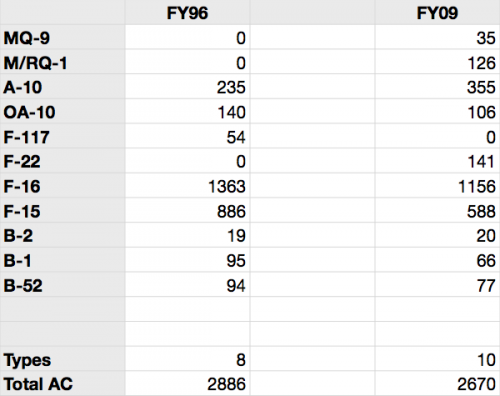The F-35 tries to do a little of just about every mission. According to some people this is a weakness, not a strength, as it doesn't really do those jobs as well as dedicated platforms. I do not think that the people arguing in favor of alternatives to the F-35 are suggesting that a single platform do all of those jobs, for the same reasons.
And this is the heart of the matter. A lot of people say the good old days are gone and theres no money left. They are right. If you think the JSF is expensive, wait until you have five aircraft to feed and house trying to do to individual specialized jobs. especially when those airframes are old and havnt been in production for i(n some cases,) decades. not to mention the legions of technicians and spare parts require to keep large varied fleets operating.
its the difference between taking an accounting ledger and comparing the price of aircraft initially, and breaking out Jane's military aircraft and looking at the performance and initial price and making your decision from there. Reality is different. there are thousands of factors to include Maintainability, performance in different enviroments and in different envelops myriad missions, spare parts, survivability, combat effectiveness, turn around time maint hours/vs flight hours, depot maintenence, specialized calibration equipment, lifespan of parts, specialized hangers, the list goes on and on.
Its like saying the cost of having a child is just that of the first ultra sound. Hold on to your hat, because its only going to get more expensive over time!
So its easy to say "for the price of one F-15 I can get 2 A-10s and 4 Tucanos"... but how about all those other factors? But of course it costs 5 million dollars to train a military pilot. So the Tucano's have an additional price of pilot training, since there are more of them, they need more spares that may not be avaliable, more hangers and of course the Tucanos are worthless outside of COIN. so fleets of aircraft men and material for a small mission.
Combat effectiveness? We are seeing the limits already. As soon as reports of SA-18s in Libya came out, the A-10 was immediately restricted from operating in suspected SA-18 areas. So theres an example of a wonderful specialized aircraft, being completed and utterly benched when the moment of truth arrived. Even an F-15C modified with a few bombs is better than no bombs at all. (F-15Es of course operated wherever they desired)
The USAF operates from the top down with missions. Its going to be Air superiority first, SEAD, deep strike, and then all the other nice to have things like battlefield interdiction and CAS later. If it runs out of money, then the bottom missions and their aircraft get dropped. bye bye warthog. The planes that can do the greater variety of missions get kept, because its more bang for the buck.
So you can have a single non specialized aircraft that does a lot of missions very very well actually. or you can have many aircraft that can do a few missions perfectly, but with certain missions utterly ignored for budgetary reasons. You can't have many aircraft doing a few perfect missions each with the full spectrum covered. There simply isn't enough. So one way or another, the A-10 is going the way of the dinosaur. Because if it comes between CAS or deep strike, deep strike wins every time.
This stuff is chess, not checkers. There are considerations that go well beyond the initial numbers and the apparatus (Men, machines, material, training, administration, etc) that maintains warplanes is massive.
Even if the JSF gets canceled tomorrow, Legacy aircraft are old, outdated, and in need of replacement. They get more difficult and expensive every year
Specialization is long gone, and the world has been trending to multirole for sometime now.




